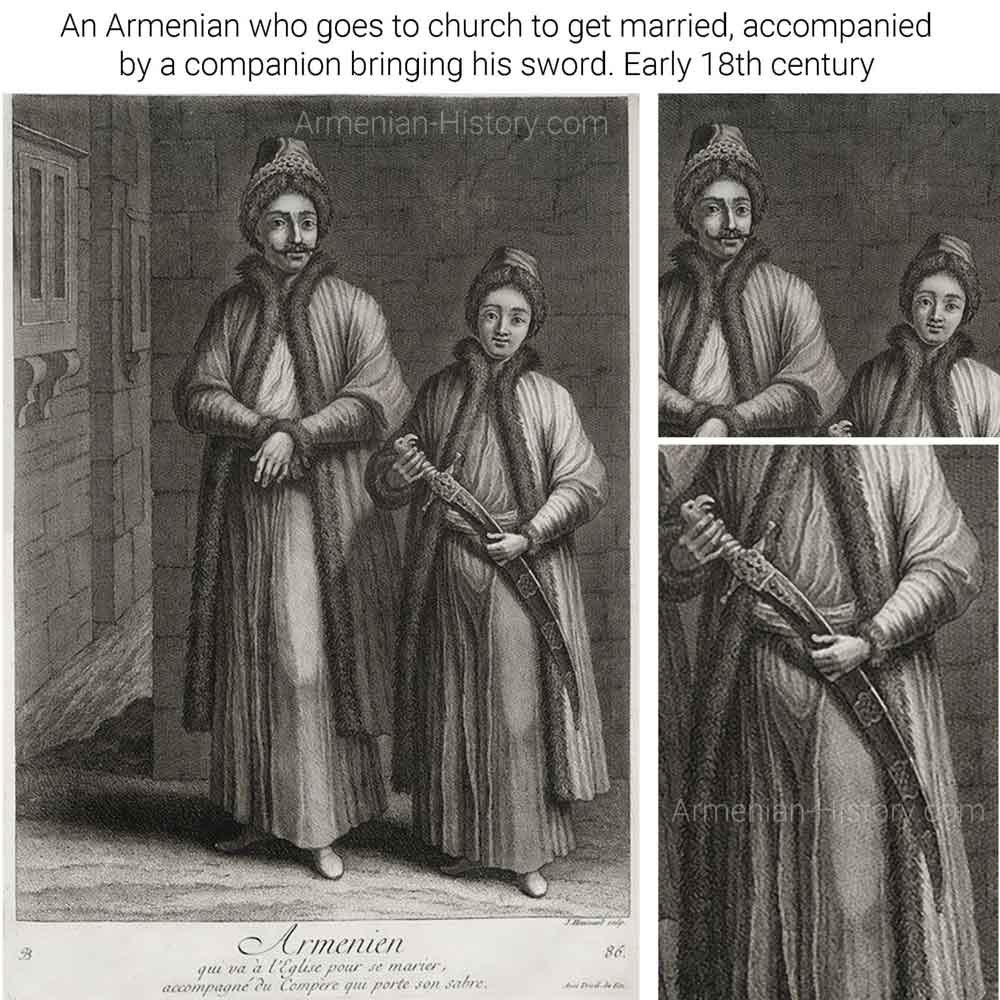The customs and traditions of Armenian weddings are deeply rooted in the history and culture of the Armenian people. Through the centuries, these traditions have evolved but continue to hold immense cultural and symbolic significance. A remarkable painting by Jean-Baptiste Vanmour (1671-1737) offers us a glimpse into one such wedding tradition from the early 18th century, set during the time of Ottoman rule.
The Painting: A Glimpse into the Past

Jean-Baptiste Vanmour, a French artist famous for his detailed depictions of life in the Ottoman Empire, painted many cultural scenes, including this one featuring an Armenian man on his way to church for his wedding. In the painting, the groom is accompanied by a companion holding his sword. This simple yet powerful image speaks volumes about the cultural norms and the ceremonial aspects of Armenian life under Ottoman rule.
The painting, titled “Armenien qui va à l’Eglise pour se marier, accompagné du Compère qui porte son sabre” (An Armenian who goes to the church to get married, accompanied by a companion bringing his sword), reveals much about the significance of Armenian wedding traditions. The sword, symbolizing honor and protection, was an integral part of the wedding procession, perhaps symbolizing the groom’s readiness to protect his family and new household.
Armenian Weddings in the Ottoman Era
Armenians, as one of the largest Christian minorities in the Ottoman Empire, managed to preserve their cultural identity, despite living under foreign rule. Weddings were not only personal celebrations but also communal events that reinforced Armenian traditions, faith, and unity.
During the 18th century, Armenian wedding ceremonies were rich with rituals that underscored the importance of family, faith, and community. The wedding process often began with a ceremonial engagement, followed by the religious wedding held in the Armenian Apostolic Church. It was typical for the groom to be accompanied by family members and close friends, and in some cases, a symbolic object like a sword, as seen in Vanmour’s painting.
Symbolism and Heritage
The sword, as portrayed in the painting, carried deep symbolic meaning in the Armenian tradition. It signified strength, honor, and protection — values that were not only integral to the groom but to Armenian society as a whole. The act of bringing the sword to a wedding might also represent a pledge to defend the sanctity of marriage and family life, which were held in high regard.
The tradition of escorting the groom with a sword-bearer further highlights the communal nature of Armenian weddings. It wasn’t just about two individuals uniting in marriage; it was about the entire community coming together to support and celebrate this sacred union.
Jean-Baptiste Vanmour and His Influence
Vanmour’s body of work provides significant insight into the cultural and social life of various communities in the Ottoman Empire, including the Armenians. His portraits and scenes often included detailed costumes, accessories, and ceremonial practices, making his works invaluable for historians and art enthusiasts alike.
While Vanmour is known for his depictions of Ottoman sultans and high-ranking officials, his portrayal of minority groups such as the Armenians is equally significant. These paintings allow us to understand how Armenians navigated their cultural identity under Ottoman rule and how they preserved their unique traditions in a foreign environment.
Conclusion
Jean-Baptiste Vanmour’s painting of an Armenian groom on his way to church, accompanied by a sword-bearer, is more than just a work of art; it is a cultural artifact that offers us a rare glimpse into Armenian wedding customs in the 18th century. This scene serves as a reminder of the enduring nature of Armenian traditions and the resilience of the Armenian people, who managed to preserve their identity even under foreign rule.

